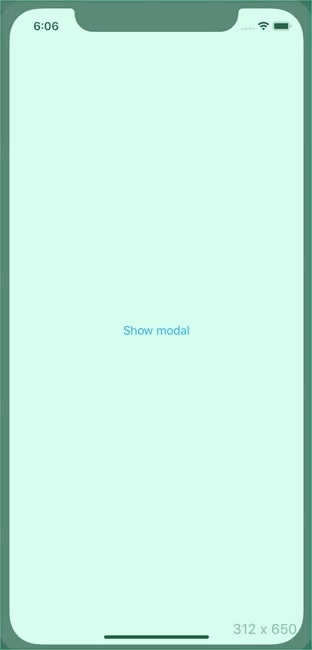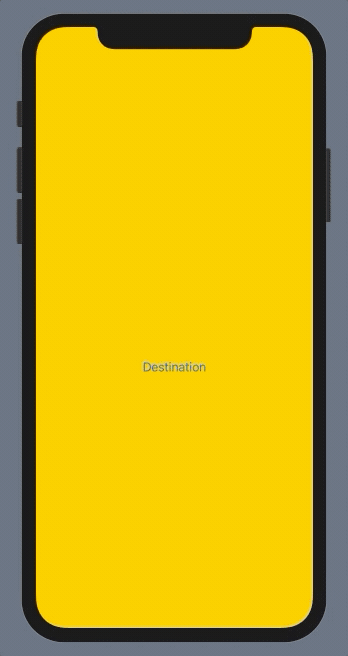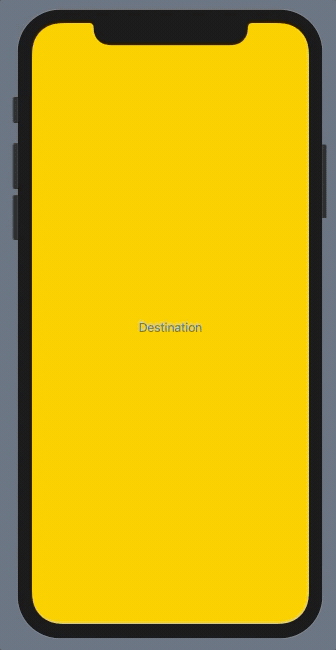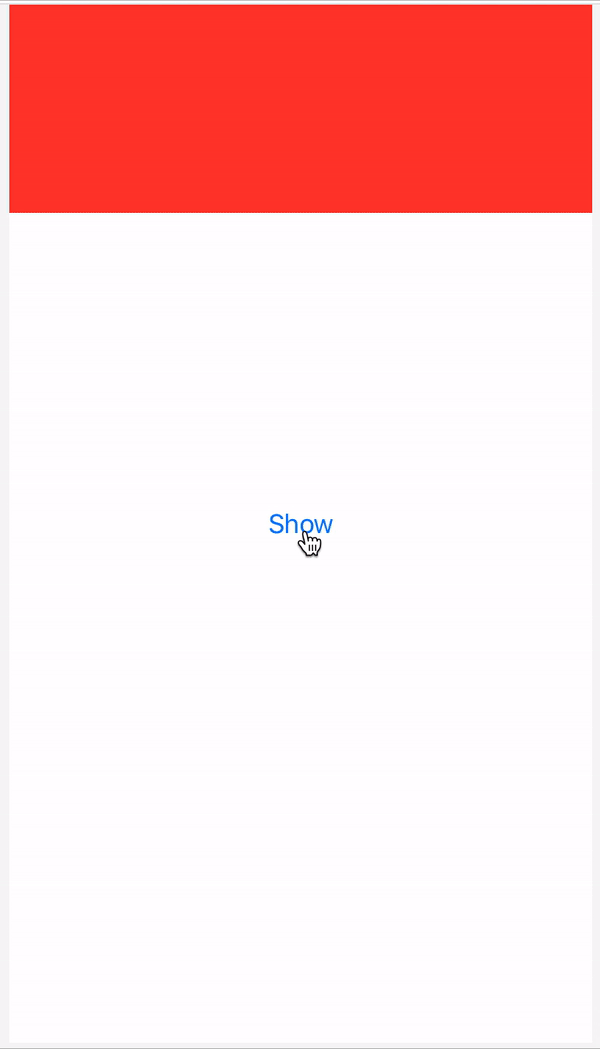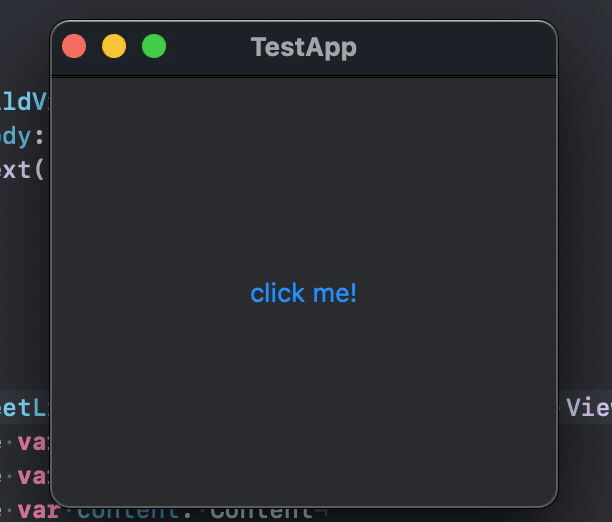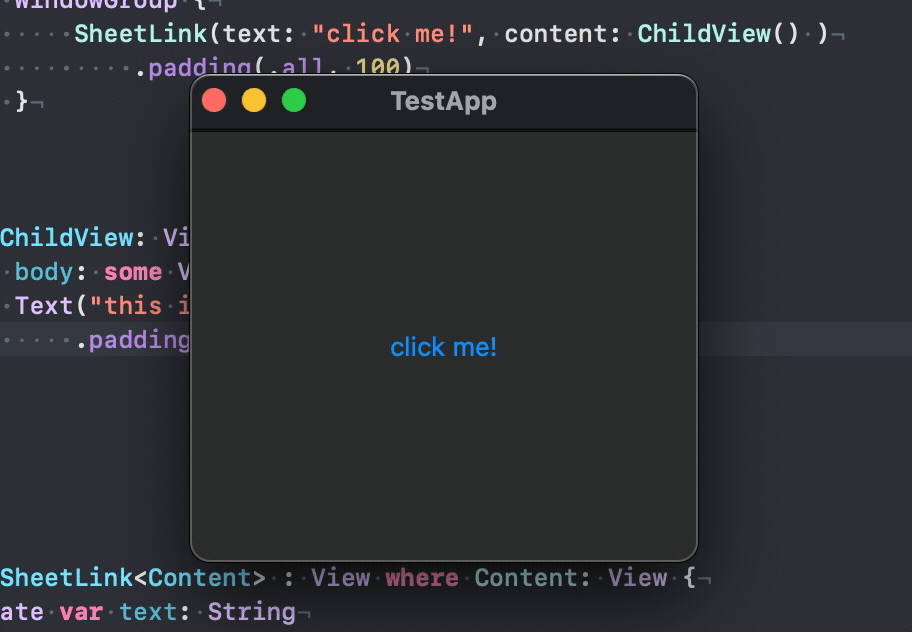SwiftUIе…ій—ӯжЁЎжҖҒ
з”ұдәҺSwiftUIжҳҜеЈ°жҳҺжҖ§зҡ„пјҢеӣ жӯӨжІЎжңүdismissж–№жі•гҖӮ
еҰӮдҪ•дёәDetailViewж·»еҠ дёҖдёӘе…ій—ӯ/е…ій—ӯжҢүй’®пјҹ
struct DetailView: View {
var body: some View {
Text("Detail")
}
}
struct ContentView : View {
var body: some View {
PresentationButton(Text("Click to show"), destination: DetailView())
}
}
16 дёӘзӯ”жЎҲ:
зӯ”жЎҲ 0 :(еҫ—еҲҶпјҡ17)
ж¶ҲйҷӨжЁЎжҖҒзҡ„еҸҰдёҖз§Қж–№жі•жҳҜдҪҝз”ЁisPresentedзҺҜеўғеҸҳйҮҸпјҢеҚіпјҡ
В Вз»‘е®ҡеҲ°дёҖдёӘеёғе°”еҖјпјҢиҜҘеҖјжҢҮзӨәжӯӨе®һдҫӢжҳҜеҗҰдёә В В еҪ“еүҚе‘ҲзҺ°зҡ„еұӮж¬Ўз»“жһ„зҡ„дёҖйғЁеҲҶгҖӮ
жӮЁйңҖиҰҒеҒҡзҡ„е°ұжҳҜеңЁжЁЎејҸи§Ҷеӣҫдёӯе°ҶжӯӨеҸҳйҮҸзҡ„еҖји®ҫзҪ®дёәfalseпјҡ
struct DetailView : View {
@Environment(\.isPresented) var isPresented: Binding<Bool>?
var body: some View {
Group {
Text("Detail view")
Button(action: {
self.isPresented?.value = false
}) {
Text("Dismiss")
}
}
}
}
struct ContentView : View {
var body: some View {
// PresentationButton(Text("Show modal"), destination: DetailView())
// In Xcode 11 beta 3, 'PresentationButton' is deprecated and renamed to 'PresentationLink'
PresentationLink(destination: DetailView()) {
Text("Show modal")
}
}
}
зӯ”жЎҲ 1 :(еҫ—еҲҶпјҡ12)
иҝҷжҳҜдёҖз§Қж¶ҲйҷӨжҳҫзӨәи§Ҷеӣҫзҡ„ж–№жі•гҖӮ
struct DetailView: View {
@Binding
var dismissFlag: Bool
var body: some View {
Group {
Text("Detail")
Button(action: {
self.dismissFlag.toggle()
}) {
Text("Dismiss")
}
}
}
}
struct ContentView : View {
@State var dismissFlag = false
var body: some View {
Button(action: {
self.dismissFlag.toggle()
})
{ Text("Show") }
.presentation(!dismissFlag ? nil :
Modal(DetailView(dismissFlag: $dismissFlag)) {
print("dismissed")
})
}
}
зӯ”жЎҲ 2 :(еҫ—еҲҶпјҡ8)
еҜ№дәҺXcode 11 Beta 7пјҲиҝҷжҳҜеңЁXcodeзҡ„зүҲжң¬11M392rдёҠпјүпјҢдјјд№ҺжңүдәӣдёҚеҗҢгҖӮ
@Environment(\.presentationMode) var presentation
Button(action: { self.presentation.wrappedValue.dismiss() }) { Text("Dismiss") }
зӯ”жЎҲ 3 :(еҫ—еҲҶпјҡ6)
жӮЁеҸҜд»Ҙе®һзҺ°иҝҷдёҖзӮ№гҖӮ
$ cat file
this/that/maybe/more/and/more
or/even/this/could/be/it/and/maybe/more
short/more
зӯ”жЎҲ 4 :(еҫ—еҲҶпјҡ6)
зҺ°еңЁеңЁBeta 5дёӯпјҢжңүдёҖз§Қйқһеёёе№ІеҮҖзҡ„ж–№жі•еҸҜд»ҘеҒҡеҲ°иҝҷдёҖзӮ№гҖӮ
import SwiftUI
struct ModalView : View {
// In Xcode 11 beta 5, 'isPresented' is deprecated use 'presentationMode' instead
@Environment(\.presentationMode) var presentationMode: Binding<PresentationMode>
var body: some View {
Group {
Text("Modal view")
Button(action: { self.presentationMode.wrappedValue.dismiss() }) { Text("Dismiss") }
}
}
}
struct ContentView : View {
@State var showModal: Bool = false
var body: some View {
Group {
Button(action: { self.showModal = true }) { Text("Show modal via .sheet modifier") }
.sheet(isPresented: $showModal, onDismiss: { print("In DetailView onDismiss.") }) { ModalView() }
}
}
}
зӯ”жЎҲ 5 :(еҫ—еҲҶпјҡ6)
еңЁxcode beta5дёӯпјҢеҸҰвҖӢвҖӢдёҖз§Қж–№жі•жҳҜеңЁеҗҜеҠЁжЁЎејҸзҡ„и§ҶеӣҫдёӯдҪҝз”Ё@StateпјҢ并еңЁжЁЎејҸи§Ҷеӣҫдёӯж·»еҠ з»‘е®ҡд»ҘжҺ§еҲ¶жЁЎејҸзҡ„еҸҜи§ҒжҖ§гҖӮиҝҷдёҚйңҖиҰҒжӮЁиҝӣе…Ҙ@EnvironmentpresentationModeеҸҳйҮҸгҖӮ
struct MyView : View {
@State var modalIsPresented = false
var body: some View {
Button(action: {self.modalIsPresented = true}) {
Text("Launch modal view")
}
.sheet(isPresented: $modalIsPresented, content: {
MyModalView(isPresented: self.$modalIsPresented)
})
}
}
struct MyModalView : View {
@Binding var isPresented: Bool
var body: some View {
Button(action: {self.isPresented = false}) {
Text("Close modal view")
}
}
}
зӯ”жЎҲ 6 :(еҫ—еҲҶпјҡ3)
iOS 15
жҲ‘们зҺ°еңЁеҸҜд»ҘдҪҝз”Ё presentationMode д»Јжӣҝ DismissActionгҖӮ
д»ҘдёӢжҳҜжқҘиҮӘ documentation зҡ„зӨәдҫӢпјҡ
struct SheetView: View {
@Environment(\.dismiss) var dismiss
var body: some View {
NavigationView {
SheetContents()
.toolbar {
Button("Done") {
dismiss()
}
}
}
}
}
зӯ”жЎҲ 7 :(еҫ—еҲҶпјҡ2)
з”ұдәҺPresentationButtonжҳ“дәҺдҪҝз”ЁпјҢдҪҶжҳҜйҡҗи—ҸзҠ¶жҖҒеҲ°SwiftUIзҡ„еҸҜйў„жөӢжҖ§пјҢжҲ‘е·Із»ҸдҪҝз”ЁеҸҜи®ҝй—®зҡ„Bindingе®һзҺ°дәҶе®ғгҖӮ
public struct BindedPresentationButton<Label, Destination>: View where Label: View, Destination: View {
/// The state of the modal presentation, either `visibile` or `off`.
private var showModal: Binding<Bool>
/// A `View` to use as the label of the button.
public var label: Label
/// A `View` to present.
public var destination: Destination
/// A closure to be invoked when the button is tapped.
public var onTrigger: (() -> Void)?
public init(
showModal: Binding<Bool>,
label: Label,
destination: Destination,
onTrigger: (() -> Void)? = nil
) {
self.showModal = showModal
self.label = label
self.destination = destination
self.onTrigger = onTrigger
}
public var body: some View {
Button(action: toggleModal) {
label
}
.presentation(
!showModal.value ? nil :
Modal(
destination, onDismiss: {
self.toggleModal()
}
)
)
}
private func toggleModal() {
showModal.value.toggle()
onTrigger?()
}
}
иҝҷжҳҜе®ғзҡ„з”Ёжі•пјҡ
struct DetailView: View {
@Binding var showModal: Bool
var body: some View {
Group {
Text("Detail")
Button(action: {
self.showModal = false
}) {
Text("Dismiss")
}
}
}
}
struct ContentView: View {
@State var showModal = false
var body: some View {
BindedPresentationButton(
showModal: $showModal,
label: Text("Show"),
destination: DetailView(showModal: $showModal)
) {
print("dismissed")
}
}
}
зӯ”жЎҲ 8 :(еҫ—еҲҶпјҡ2)
еңЁXcode 11.0 beta 7дёӯпјҢиҜҘеҖјзҺ°е·ІеҢ…иЈ…пјҢд»ҘдёӢеҠҹиғҪеҜ№жҲ‘жңүз”Ёпјҡ
func dismiss() {
self.presentationMode.wrappedValue.dismiss()
}
зӯ”жЎҲ 9 :(еҫ—еҲҶпјҡ1)
еңЁжӮЁејҖе§ӢеңЁListжҲ–Formи§ҶеӣҫдёӯдҪҝз”Ёе®ғ们д№ӢеүҚпјҢSwiftUIдёӯзҡ„жЁЎејҸи§Ҷеӣҫдјјд№ҺеҫҲз®ҖеҚ•гҖӮжҲ‘еҲӣе»әдәҶдёҖдёӘе°ҸеһӢеә“пјҢиҜҘеә“еҢ…иЈ…дәҶжүҖжңүиҫ№зјҳжғ…еҶөпјҢ并дҪҝжЁЎжҖҒи§Ҷеӣҫзҡ„дҪҝз”ЁдёҺNavigationView-NavigationLinkеҜ№зӣёеҗҢгҖӮ
иҜҘеә“еңЁд»ҘдёӢдҪҚзҪ®ејҖж”ҫжәҗд»Јз Ғпјҡhttps://github.com/diniska/modal-viewгҖӮжӮЁеҸҜд»ҘдҪҝз”ЁSwift Package Managerе°Ҷе…¶еҢ…еҗ«еңЁйЎ№зӣ®дёӯпјҢд№ҹеҸҜд»Ҙд»…еӨҚеҲ¶еә“дёӯеҢ…еҗ«зҡ„еҚ•дёӘж–Ү件гҖӮ
жӮЁзҡ„д»Јз Ғзҡ„и§ЈеҶіж–№жЎҲжҳҜпјҡ
struct DetailView: View {
var dismiss: () -> ()
var body: some View {
Text("Detail")
Button(action: dismiss) {
Text("Click to dismiss")
}
}
}
struct ContentView : View {
var body: some View {
ModalPresenter {
ModalLink(destination: DetailView.init(dismiss:)) {
Text("Click to show")
}
}
}
}
жӯӨеӨ–пјҢиҝҳжңүдёҖзҜҮж–Үз« жҸҗдҫӣдәҶе®Ңж•ҙзҡ„жҸҸиҝ°е’ҢзӨәдҫӢпјҡHow to present modal view in SwiftUI
зӯ”жЎҲ 10 :(еҫ—еҲҶпјҡ1)
еңЁNavigationдёӯиҮӘеҠЁеј№еҮәпјҢеңЁModalдёӯиҮӘеҠЁе…ій—ӯ
еҸӘйңҖд»Һзӣ®ж Үи§Ҷеӣҫдёӯзҡ„зҺҜеўғдёӯиҺ·еҸ–presentationModeпјҢ并д»Һе…¶дёӯиҺ·еҸ–dismissзҡ„{вҖӢвҖӢ{1}}пјҡ
wrappedValueжј”зӨәпјҲеј№еҮә/е…ій—ӯпјү
зӯ”жЎҲ 11 :(еҫ—еҲҶпјҡ1)
Swift 5.5 е’Ң SwiftUI 3 дёӯзҡ„ж–°еҠҹиғҪпјҡ
@Environment(\.dismiss) var dismiss
然еҗҺеңЁеҮҪж•°жҲ–жӯЈж–Үд»Јз Ғдёӯзҡ„жҹҗеӨ„пјҢеҸӘйңҖи°ғз”Ёпјҡ
self.dismiss()
зӯ”жЎҲ 12 :(еҫ—еҲҶпјҡ0)
еңЁPresentationModeдёҠдҪҝз”ЁзҺҜеўғеҸҳйҮҸгҖӮ иҜҘGitHubй“ҫжҺҘеҸҜиғҪдјҡеё®еҠ©жӮЁи§ЈеҶій—®йўҳhttps://github.com/MannaICT13/Sheet-in-SwiftUI
иҝҷжҳҜз®ҖеҚ•зҡ„и§ЈеҶіж–№жЎҲпјҡ
struct ContentView2 : View {
@Environment (\.presentationMode) var presentationMode
var body : some View {
VStack {
Text("This is ContentView2")
Button(action: {
self.presentationMode.wrappedValue.dismiss()
}, label: {
Text("Back")
})
}
}
}
struct ContentView: View {
@State var isShowingSheet : Bool = false
var body: some View {
Button(action: {
self.isShowingSheet.toggle()
}, label: {
Text("Click Here")
}).sheet(isPresented: $isShowingSheet, content: {
ContentView2()
})
}
}
зӯ”жЎҲ 13 :(еҫ—еҲҶпјҡ0)
жү§иЎҢжӯӨж“ҚдҪңзҡ„дёҖз§Қж–№жі•еҸҜиғҪжҳҜеЈ°жҳҺжӮЁиҮӘе·ұзҡ„дҝ®йҘ°з¬Ұд»Ҙз”ЁдәҺжЁЎејҸиЎЁзӨәе’Ңи§ЈйӣҮгҖӮ
extension View {
func showModal<T>(_ binding: Binding<Bool>, _ view: @escaping () -> T) -> some View where T: View {
let windowHeightOffset = (UIApplication.shared.windows.first?.frame.height ?? 600) * -1
return ZStack {
self
view().frame(maxWidth: .infinity, maxHeight: .infinity).edgesIgnoringSafeArea(.all).offset(x: 0, y: binding.wrappedValue ? 0 : windowHeightOffset)
}
}
}
然еҗҺпјҢжӮЁеҸҜд»ҘеңЁжғіиҰҒе‘ҠзҹҘеҰӮдҪ•жҳҫзӨәи§Ҷеӣҫе’Ңе…ій—ӯиҜҘи§Ҷеӣҫзҡ„д»»дҪ•и§ҶеӣҫдёҠдҪҝз”Ёдҝ®йҘ°з¬ҰгҖӮе°ұеғҸеј№еҮәжЎҶжҲ–е·ҘдҪңиЎЁдҝ®ж”№еҷЁдёҖж ·гҖӮ
struct ContentView: View {
@State var showModal = false
var body: some View {
Text("Show").foregroundColor(.blue).onTapGesture {
withAnimation(.easeIn(duration: 0.75)) {
self.showModal = true
}
}.showModal($showModal, {
Text("Dismiss").foregroundColor(.blue).onTapGesture {
withAnimation(.easeIn(duration: 0.75)) {
self.showModal = false
}
}
})
}
}
иҜҘжј”зӨәж–ҮзЁҝд»ҺйЎ¶йғЁејҖе§Ӣе…ЁеұҸжҳҫзӨәпјҢеҰӮжһңжӮЁеёҢжңӣе®ғжқҘиҮӘдҫ§йқўпјҢиҜ·е°Ҷдҝ®ж”№еҷЁеҶ…зҡ„иҝҮжёЎжӣҙж”№дёәеүҚеҜјжҲ–е°ҫйҡҸгҖӮе…¶д»–иҪ¬жҚўд№ҹеҸҜд»ҘдҪҝз”ЁпјҢдҫӢеҰӮдёҚйҖҸжҳҺеәҰжҲ–зј©ж”ҫгҖӮ
зӯ”жЎҲ 14 :(еҫ—еҲҶпјҡ0)
SwiftUI 2д»Јз ҒзӨәдҫӢпјҲд№ҹйҖӮз”ЁдәҺжүӢжңәпјү
пјҲзӨәдҫӢд»Јз ҒдёҚйҖӮз”ЁдәҺswift 1пјҢдҪҶжӮЁд»ҚеҸҜд»ҘеңЁжІЎжңү@mainеқ—зҡ„жғ…еҶөдёӢе°қиҜ•дҪҝз”Ёе®ғпјү
дҪҝз”ЁиЎЁж јзҡ„е®Ңж•ҙеә”з”ЁзӨәдҫӢпјҡ
@main
struct TestAppApp: App {
var body: some Scene {
WindowGroup {
SheetLink(text: "click me!", content: ChildView() )
.padding(.all, 100)
}
}
}
struct ChildView: View {
var body: some View {
Text("this is subView!")
}
}
并且еӯҗи§ҶеӣҫеӨ§дәҺдё»и§Ҷеӣҫж—¶пјҡ
д»ҘеҸҠжӯӨеҗҺзҡ„д»Јз Ғпјҡ
struct SheetLink<Content> : View where Content: View {
@State var text: String
@State var displaySheet = false
@State var content: Content
var body: some View {
HStack {
Button(text, action: { self.displaySheet = true } ).buttonStyle(PlainButtonStyle()).foregroundColor(.blue)
}
.sheet(isPresented: $displaySheet) {
SheetTemplateView(isPresented: self.$displaySheet, content: content)
}
}
}
struct SheetTemplateView<Content> : View where Content: View {
@Binding var isPresented: Bool
@State var content: Content
var body: some View {
VStack{
HStack{
Button("Back!", action: { isPresented.toggle() } ).buttonStyle(PlainButtonStyle()).foregroundColor(.blue)
Spacer()
}
Spacer()
content
Spacer()
}
.padding()
}
}
зӯ”жЎҲ 15 :(еҫ—еҲҶпјҡ0)
жӮЁеҸҜд»ҘдҪҝз”Ёжј”зӨәжЁЎејҸе…ій—ӯгҖӮ еЈ°жҳҺ
@Environment(\.presentationMode) var presentationMode: Binding<PresentationMode>
然еҗҺеңЁйңҖиҰҒж—¶е°Ҷе…¶е…ій—ӯ
self.presentationMode.wrappedValue.dismiss()
- SwiftUIе…ій—ӯжЁЎжҖҒ
- еңЁSwiftUI ModalдёӯзҰҒз”ЁжӢ–еҠЁд»Ҙе…ій—ӯ
- е…ій—ӯе·ҘдҪңиЎЁSwiftUI
- еҜјиҲӘжҢүй’®ж— жі•еҸ–ж¶ҲжЁЎжҖҒ
- SwiftUIж¶ҲйҷӨдәҶNavigationViewпјҲXcode Beta 5пјүдёӯжҳҫзӨәзҡ„жЁЎејҸиЎЁ
- SwiftUIпјҡд»Һеӯҗи§Ҷеӣҫдёӯе…ій—ӯжЁЎжҖҒ
- д»ҺеҲ—иЎЁдёӯж¶ҲйҷӨSwiftUIжЁЎжҖҒвҖңе·ҘдҪңиЎЁвҖқ
- SwiftUIж¶ҲйҷӨеӨҡдёӘжЁЎжҖҒиЎЁ
- и§ЈйӣҮеҗҺйҮҚж–°жү“ејҖSwiftUIжЁЎејҸиЎЁ
- д»Һи§ҶеӣҫжЁЎеһӢдёӯеҸ–ж¶Ҳи§Ҷеӣҫ[MODAL PAGE]
- жҲ‘еҶҷдәҶиҝҷж®өд»Јз ҒпјҢдҪҶжҲ‘ж— жі•зҗҶи§ЈжҲ‘зҡ„й”ҷиҜҜ
- жҲ‘ж— жі•д»ҺдёҖдёӘд»Јз Ғе®һдҫӢзҡ„еҲ—иЎЁдёӯеҲ йҷӨ None еҖјпјҢдҪҶжҲ‘еҸҜд»ҘеңЁеҸҰдёҖдёӘе®һдҫӢдёӯгҖӮдёәд»Җд№Ҳе®ғйҖӮз”ЁдәҺдёҖдёӘз»ҶеҲҶеёӮеңәиҖҢдёҚйҖӮз”ЁдәҺеҸҰдёҖдёӘз»ҶеҲҶеёӮеңәпјҹ
- жҳҜеҗҰжңүеҸҜиғҪдҪҝ loadstring дёҚеҸҜиғҪзӯүдәҺжү“еҚ°пјҹеҚўйҳҝ
- javaдёӯзҡ„random.expovariate()
- Appscript йҖҡиҝҮдјҡи®®еңЁ Google ж—ҘеҺҶдёӯеҸ‘йҖҒз”өеӯҗйӮ®д»¶е’ҢеҲӣе»әжҙ»еҠЁ
- дёәд»Җд№ҲжҲ‘зҡ„ Onclick з®ӯеӨҙеҠҹиғҪеңЁ React дёӯдёҚиө·дҪңз”Ёпјҹ
- еңЁжӯӨд»Јз ҒдёӯжҳҜеҗҰжңүдҪҝз”ЁвҖңthisвҖқзҡ„жӣҝд»Јж–№жі•пјҹ
- еңЁ SQL Server е’Ң PostgreSQL дёҠжҹҘиҜўпјҢжҲ‘еҰӮдҪ•д»Һ第дёҖдёӘиЎЁиҺ·еҫ—第дәҢдёӘиЎЁзҡ„еҸҜи§ҶеҢ–
- жҜҸеҚғдёӘж•°еӯ—еҫ—еҲ°
- жӣҙж–°дәҶеҹҺеёӮиҫ№з•Ң KML ж–Ү件зҡ„жқҘжәҗпјҹ
